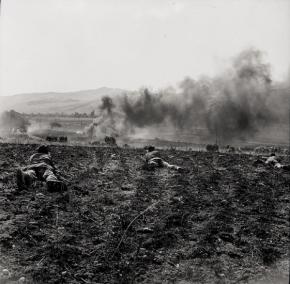History of the Mission
On July 10, 1943, as Operation Husky, the invasion of the island of Sicily unfolded, the men of the First Canadian Division sallied forth. The Division was made up on the First Brigade (the Royal Canadian Regiment, the 48th Highlanders of Canada and the Hastings and Prince Edward Regiment), the Second Brigade (the Princess Patricia’s Canadian Light Infantry, the Loyal Edmonton Regiment and the Seaforth Highlanders of Canada), and the Third Brigade (the Royal 22e Regiment, the Carleton and York Regiment and the West Nova Scotia Highlanders). The infantry brigades were supported by the the Royal Canadian Horse Artillery, the Second Field Regiment, and the Third Field Regiment, respectively. In addition, the Saskatoon Light Infantry (Machine Gun), 1st Anti-Tank Regiment, 2nd Light Anti-Tank Regiment and the 4th Reconnaissance Regiment (4th Princess Louise Dragoon Guards). Armoured support came from the 1st Canadian Armoured Brigade made up of the Ontario Regiment, the Calgary Regiment and the Three Rivers Regiment.
The Canadians secured their objectives, fitting in between the US Army on the left and the British Eighth Army on the right. The Germans drew blood all along their retreat-Garammichele, Piazza Armeria, Valguernara, the highway 4 and 192 intersection, Leoneforte, Assoro, Nissoria, Agira, Regalbuto and Catenanuova, among others. Strategically, they had broken the Germans’ flank, forcing the German left flank to fall back, allowing the British to move forward from their bloody stalemate on Catania Plain. By the end of August, the remaining Germans in Sicily had retreated.
The July-August campaign marks the first time that a Canadian corps had struck a blow against the enemy since the war began in 1939. It was an arduous campaign, fought on hot, dusty countryside, devoid of shade and plagued with malaria. The first Canadian Corps was well trained but inexperienced. Nonetheless, though the Germans exacted a toll of 487 Canadian dead in Sicily, the Canadians had killed a far greater number of Germans and pushed them back. The Canadians gave better than they got.
The First Canadian Corps deserves to be remembered. Here was a combined force that not only had Canadian armour providing close support for Canadian infantry, but represented a reflection of Canada. All the infantry brigades were made up on one Permanent force unit and two NPAM (Non-Permanent Army Militia) regiments. And the battalions represented all parts of the country.
Read more about the campaign by visiting www.junobeach.org | Support your brothers and Join the Campaign!
